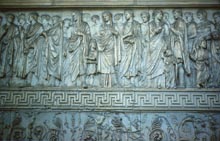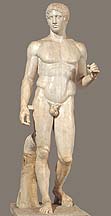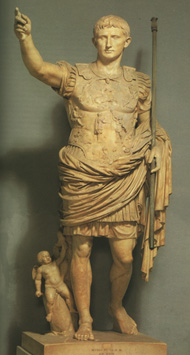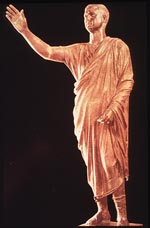|
|
|
|
| Augustus of Primaporta, c. 20 B.C. | Arringatore (Orator), Aulus Metellus, 1st c. B.C. | |

|
||
| Heads of Augustus with Civic Crown. Left=Louvre; Right=Munich | Polykleitos, Doryphoros, 450-440 B.C. | |
| Augustus as Pontifex Maximus. Augustus became Pontifex maximus in 13 BCE | Togatus statue of Augustus, Louvre, head dated between 30-20BC; the body probably comes from the 2nd century AD. It represents Augustus as a magistrate. | |

|

|
|
| Ara Pacis (Altar of Peace), 13-9 B.C. | Tellus Relief (Earth, Air, and Sea personified), from the Ara Pacis. | |

|
||
| Aeneas Sacrificing, from the Ara Pacis. | ||

|

|
|
| Imperial Procession from the Ara Pacis | Detail of the Panathenaic procession from the Parthenon, c. 447-432 B.C. | |

|

|
|
| Model of the Forum of Augustus with the Temple of Mars Ultor, late 1st c. B.C. | Remains of the Temple of Mars Ultor. | |

|
||
| Plan of the Forum of Augustus. | Temple of Fortuna Virilis, late 2nd c. B.C. | |

|
||
| Maison Carée, c. 19 B.C., Nîmes, France. | Pont du Gard (Aqueduct), late 1st c. B.C., near Nîmes, France. | |
Terms
Imperator: this was originally a title for a commander of the military during the Roman Republic. As commander of the military Augustus was identified as "imperator." This term ultimately expands to embrace all the authority of the Roman leader or Emperor.
Cuirass statue: image of a Roman general or leader wearing a military breastplate or cuirass.
Ad locutio: the gesture of the arm raised to signify the active speaker. It is the gesture of authority in Roman art.
Togatus: figure wearing a toga, the formal, civilian dress of Rome.
Supplementary Web page
Roman Power and Roman Imperial Sculpture
Excerpts from Virgil's Aeneid.
Wikipedia pages: Augustus, Aeneas, Romulus and Remus














